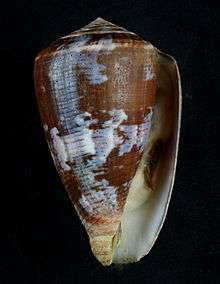Conus purpurascens
| Conus purpurascens | |
|---|---|
 | |
| Shell of Conus purpurascens G. B. Sowerby I, 1833, with operculum, measuring 83.7 mm in height, collected at low tide on Venudo Island, in Panama | |
| Scientific classification | |
| Kingdom: | Animalia |
| Phylum: | Mollusca |
| Class: | Gastropoda |
| Clade: | Caenogastropoda |
| Clade: | Hypsogastropoda |
| Clade: | Neogastropoda |
| Superfamily: | Conoidea |
| Family: | Conidae |
| Genus: | Conus |
| Species: | C. purpurascens |
| Binomial name | |
| Conus purpurascens G. B. Sowerby I, 1833 | |
| Synonyms[1] | |
| |
Conus purpurascens, common name the purple cone, is a species of sea snail, a marine gastropod mollusk in the family Conidae, the cone snails and their allies.[1]
Like all species within the genus Conus, these snails are predatory and venomous. They are capable of "stinging" humans, therefore live ones should be handled carefully or not at all. Conantokin-P is a toxin derived from the venom of Conus purpurascens.
Description
The size of the shell varies between 33 mm and 80 mm. The shell is broad-shouldered, with a rude, striate spire. It is striate below, and the string sometimes is slightly granular. The shell is clouded with white or violaceous and brown or olive, with close lines of chestnut and white minute articulations. Sometimes it is irregularly white-banded in the middle. [2]
Distribution
This species occurs in the Central Pacific, off the Galapagos Islands and in the Gulf of California, Mexico.
References
- Petit, R. E. (2009). George Brettingham Sowerby, I, II & III: their conchological publications and molluscan taxa. Zootaxa. 2189: 1–218
- Puillandre N., Duda T.F., Meyer C., Olivera B.M. & Bouchet P. (2015). One, four or 100 genera? A new classification of the cone snails. Journal of Molluscan Studies. 81: 1-23
 Conus purpurascens Broderip, W.J., 1833
Conus purpurascens Broderip, W.J., 1833 Conus purpurascens Broderip, W.J., 1833
Conus purpurascens Broderip, W.J., 1833 Conus purpurascens Broderip, W.J., 1833
Conus purpurascens Broderip, W.J., 1833 Conus purpurascens Broderip, W.J., 1833
Conus purpurascens Broderip, W.J., 1833
External links
- The Conus Biodiversity website
- Cone Shells - Knights of the Sea
- Gastropods.com: Chelyconus purpurascens